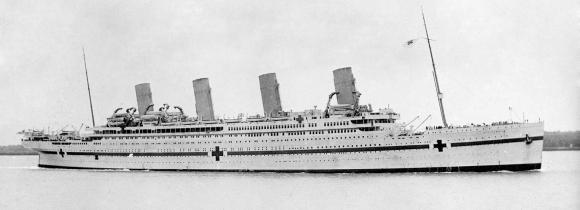
HMHS Britannic
Titanic had two sisters — the Olympic and the Britannic. While the Olympic had a productive 24 year operating life, the Britannic was only slightly more lucky than her ill-fated sister, Titanic. Just over 100 years ago, on November 21, 1916, His Majesty’s Hospital Ship (HMHS) Britannic sank after hitting a German mine on the morning of November 21, 1916, off the Greek island of Kea in the Adriatic. Unlike the Titanic, which sank with the loss of more than 1500 in 1911, only 30 on the Britannic perished. Of the 1,065 people on board; 1,035 survivors were rescued from the water and lifeboats.
The Britannic was the third of the White Star Line’s Olympic class of luxury liners. She was delivered in 1915, just before the start of World War I. Rather than be put into trans-Atlantic service, she was initially laid up and then put into service as a hospital ship in late 1915. She was described as “the most beautiful hospital ship that ever sailed the seas.” In less than a year, she would be at the bottom of the Adriatic. The Britannic was the largest British ship lost during World War I and remains the largest sunken ocean liner in the world.
The wreck of HMHS Britannic was first discovered and explored in about 400 feet by Jacques Cousteau in 1975. Below is a video of the ship’s history and of diving on the wreck in honor of the 100th anniversary of the sinking.

Also one of the female crew members who was in Titanic and saved was also in Britannic and saved. One of the reasons loss of life was so small was sufficient lifeboats on board, crew training in evacuation, weather and sinking rate. Safety training had been introduced and was required for all crew members in 1916 and regular drills held.
Good Watch.
Also one of the female crew members who was in Titanic and saved was also in Britannic and saved. One of the reasons loss of life was so small was sufficient lifeboats on board, crew training in evacuation, weather and sinking rate. Safety training had been introduced and was required for all crew members in 1916 and regular drills held.
Good Watch.
Also one of the female crew members who was in Titanic and saved was also in Britannic and saved. One of the reasons loss of life was so small was sufficient lifeboats on board, crew training in evacuation, weather and sinking rate. Safety training had been introduced and was required for all crew members in 1916 and regular drills held.
Good Watch.
One has no idea how this came up three times – maybe a safety point was being made !!!!!!!!!!!!!
Good Watch.